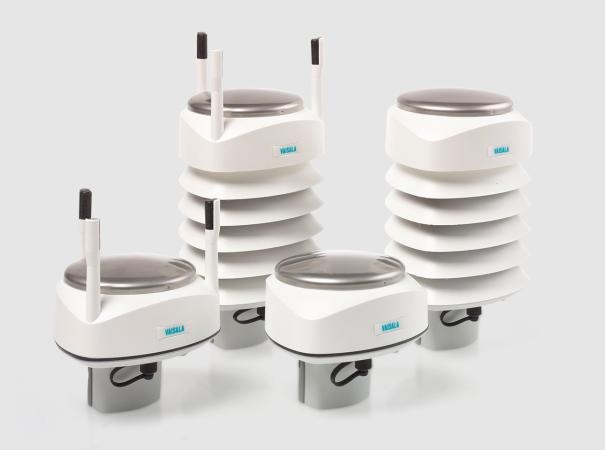Speaker

Tim Nicoll
Tim Nicoll has been with Vaisala since February of 1988, first working as a production technician, then moving into manufacturing as a manager and engineer.
Today, he is a System Integration Engineer and has worked with nearly every sensor and system within Vaisala over the past 29 years. He specializes in designing custom one-of-a-kind weather systems and networks, integrating third party sensors, and integrating Vaisala systems into customer networks.
Questions & Answers
Is the PTU module basically the same as what you find in a radiosonde?
It uses the same measurement technology HUMICAP® relative humidity sensor and BAROCAP® pressure sensor. However, the temperature sensor and electronics are different.
Is the WXT compatible with the CR6 Campbell acquisition?
It can be integrated with the CR6 with the use of the analog outputs or the Nokeval 7470 module.
Is the WXT530 Series designed for mobile applications or just stationary deployments?
It can be used with either. On a mobile application, the user will need to manage the direction offset by either entering an offset into the WXT manually, or adding a data logger, such as the Vaisala QML, to accept the WXT data, and a compass. Then you can make the wind direction change. Vaisala has experience with these methods for numerous mobile systems.
Is there snow collection mitigation?
You can add a snow height sensor to the WXT. Vaisala uses the APG IRU-9429, but other sensors with the required output can also be used.
What are the calibration intervals for the sensors?
Vaisala recommends every two years. Your specific installation might change this recommendation. It is up to the individual customer and their use of the sensor.
How we can validate and calibrate the WXT?
The user cannot calibrate the WXT. This is done prior to leaving the factory, and the calibration needed after that is the changing of the PTU module (the new PTU module comes calibrated with a calibration sheet). To validate the sensor, you can use a calibrated set of PTU sensors to compare to the WXT, for the wind a simple zero wind check can be done by simply placing a box over the sensor, making sure not to let it touch the wind sensors prongs. The precipitation is as simple as just tapping the metal plate on the top of the WXT and making sure the reading changes.
You mentioned that no calibration is needed, only to change the PTU unit, but who calibrates this unit?
The PTU module is calibrated by Vaisala, and the calibration is traceable to national standards. Pressure and temperature calibration is traceable to NIST, and the relative humidity is traceable to MIKES. After you change a PTU module, the old one is just is disposable and not re-calibrated.
How do you install the wind sensor on a vessel; where is the reference for the north point?
On a ship, you need to install the sensor at the highest point possible, where there are no obstructions around the sensor. You can either pole mount the sensor or mount it to a flat surface. Normally the sensor North is aligned with the ship's bow.
How does the wind direction correction work?
In the Configuration Tool, there is an icon for sensor settings. In this menu there is a place to enter a direction offset. Enter the direction offset and the WXT will apply the offset to the wind direction to correct it to the proper reading.
How can I set a direction offset from the Configuration Tool?
The Configuration Tool has a set of icons on the menu bar, and there is an icon for Sensor Setting. In this menu, there is a place to enter a direction offset.
Is the way to analyze the database to use the Vaisala Configuration Tool?
No, the Configuration Tool is only for configuring the sensor and checking to make sure it is working properly. To store the data you will need another software package, such as the Vaisala MCC201.
Is it possible to use any combination on the analog inputs (for example two radiometers - UV and IR), or only the options that appear on the Configuration Tool?
The two analog ports have specific uses: port one is for a solar radiation sensor only, port two is for an external temperature, level sensor, or tipping bucket. Only one solar sensor and one of the other two can be used at the same time.
Can we connect the WXT transmitter with the QML data logger and/or the MAWS301?
Yes, and it will require the configuration of the MAWS301 to be changed.
Do you have an example of the set-up process through a HyperTerminal (without using the Configuration Tool) and a document with all ASCII commands?
Currently there is no document available with an example; however, you can contact Vaisala for any additional documentation requirements. All of the ASCII commands are in the WXT manual.
If you did not order a Service port in the transmitter, can you connect your laptop directly with the internal connector?
All sensors have the service port. You can connect a laptop directly to the internal connectors of the WXT. Gland fittings are provided with the sensor, so you can add your own cable and wire directly to the terminal strip inside the WXT.
Is there any pin out configuration of the sensor end of USB cable or Service cable?
It is available. However, please contact your Vaisala Sales Manager to discuss ordering this particular part.
We have seen a WXT534 with cables around the sensor to protect it against a fall, does this affect the readings?
As long as the cables do not interfere with airflow into the PTU module and do not cause wind disturbance around the wind sensors, no, it will not affect the readings.
Is the WXTPTUSP supplied with a calibration certificate?
It is supplied with a calibration sheet.
Does the WXT have protection against thunderstorms, etc.? What about other factors?
The WXT530 does not have built-in lightning protection. Due to the location and mounting (at the top of a pole, for example) in the field, the sensor is susceptible to lightning. However, using the WSP150 will help protect the WXT. It is designed to protect the data logger, computer, or other electronics that are connected to the WXT.
If I need a traceable calibration for a wind sensor should I send it to Vaisala? (Sometimes a user wants a traceable calibration certificate for each parameter.)
The WXT530 can be ordered with an accredited wind calibration. It is one of the options on the sensor order form. We also offer accredited wind calibration service (order code WINDCAL).
What is the procedure for downloading a file?
There are two ways to load configuration files into the WXT. The first is with the Configuration Tool software. This is a simple dropdown menu, where you pick the single configuration file and upload it to the WXT, or you can download the configuration from the WXT. The second way is to use Hyperterminal. In this method, you have up to six files, one for each part of the WXT (Communication, Wind, PTU, Precipitation, Analog sensor, and Supervisor). Make a Hyperterminal connection from the sensor to the data port of the WXT, and then send a text file to the sensor using the "Send TXT File" function of Hyperterminal. You can also request the configuration in the same way. Vaisala can help you with the creation of the text files, so that you get the configuration you need.
What types of antenna are there for satellite transmission?
There is no satellite transmitter for the WXT530 Series. You can connect the WXT to any communication system that you want.
What kind of control room display software or hardware modules do you have available?
The simplest display is the Vaisala MCC201 for a single WXT unit. If you want to display more, the Vaisala Network Manager NM10 software can be custom configured to display multiple WXT units.
It was mentioned that a piece of software that works as a logger, in case of a vessel configuration; is it possible to feed the software with GPS and heading and get the correction for wind speed?
No, to add any kind of compass direction correction you will need to connect the WXT and the compass to a data logger, such as the Vaisala QML. The data logger automatically applies the direction correction.
We have a full calibration lab, can we make any corrections into the sensor with the Configuration Tool?
No, the PTU module is calibrated at the factory, and no adjustments are available.
Would you define the poll mode for the WXT530?
A command is sent from a data logger. For example, the commands are aM1 for wind, aM2 for PTU, aM3 for precipitation, aM4 for the analog sensors, and aM5 for the supervisor message. The "a" is the address of the sensor.
Normally a Windows PC-based display solution is suitable, but sometimes the customer requires a small, simple display module that shows the basic weather information. Can you comment?
The Vaisala MCC201 is the simplest PC display available to view all weather parameters. As for a stand alone non-PC display, none is available at this time.
What is the NMNES sentence?
The wind NMES message looks like this: $WIXDR,A,302,D,0,A,320,D,1,A,330,D,2,S,0.1,M,0,S,0.2,M,1,S,0.2,M,2*57
PTU message: $WIXDR,C,23.3,C,0,C,24.0,C,1,H,50.1,P,0,P,1009.5,H,0*75
Precipitation message: $WIXDR,V,0.02,M,0,Z,30,s,0,R,2.7,M,0,V,0.0,M,1,Z,0,s,1,R,0.0,M,1,R,6.3,M,2,R,0.0,M,3*51
The supervisor message: $WIXDR,C,20.4,C,2,U,12.0,N,0,U,12.5,V,1,U,3.460,V,2,G,HEL/___,,4*2D.
The only other messages are the SDI-12 message and then ASCII messages.
Can Vaisala arrange a webinar to teach us the calibration procedure for humidity and temperature or for PTU?
Yes, Vaisala can schedule a webinar or provide a video about how to replace the PTU module with a newly calibrated one.
Do you offer any networking software for displaying the data?
The Vaisala MCC201 displays software for a single WXT530 unit. If you want to display more, the Vaisala Network Manager NM10 software can be custom configured to display multiple WXT units.
Can you provide links or standards on siting criteria for the wind sensor?
Yes, on pages 33 to 35 of the WXT530 Users Guide, there is information about siting the WXT.
